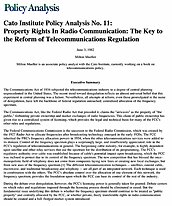The Communications Act of 1934 subjected the telecommunications industry to a degree of central planning unprecedented in the United States. The recent trend toward deregulation reflects an almost universal belief that this experiment in central planning was a failure. Nevertheless, all attempts at reform, even those promulgated in the name of deregulation, have left the backbone of federal regulation untouched: centralized allocation of the frequency spectrum.
The Communications Act, like the Federal Radio Act that preceded it, claims the “airwaves” as the property of “the public,” forbidding private ownership and market exchanges of radio frequencies. This claim of public ownership has given rise to a centralized system of licensing, which provides the legal and technical basis for many of the FCC’s other rules and regulations.
The Federal Communications Commission is the successor to the Federal Radio Commission, which was created by the 1927 Radio Act to allocate frequencies after broadcasting technology emerged in the early 1920s. The FCC inherited the FRC’s frequency allocation powers in 1934, when the other telecommunications services were added to its domain. Control of the frequency spectrum plays a surprisingly large, and insufficiently appreciated, role in the FCC’s regulation of telecommunications in general. The burgeoning cable industry, for example, is highly dependent upon satellite and other relay services that use the spectrum for the distribution of its programming. The FCC’s regulatory authority over cable was established because of cable’s potential impact upon broadcasting, which the FCC was inclined to protect due to its control of the frequency spectrum. The new competition that has blessed the once-monopolistic field of telephony does not come from companies laying new lines or creating new local exchanges, but from new uses of the frequency spectrum.[1] The different telecommunication techniques — satellites, coaxial cable, microwave, and traditional broadcasting and telephony — are all part of an integrated network. Each technique is used in combination with the others. The FCC’s absolute control over the allocation of one element of this network, the frequency spectrum, provides the foundation upon which the FCC can base its control of the rest of the industry.
During the debate over deregulation, however, the FCC’s licensing power is generally taken for granted. Debate centers on which rules and regulations imposed through the licensing process should be eliminated or eased. But the fundamental issue underlying this debate is whether the frequency spectrum should continue to be treated as “public property” and centrally allocated by the FCC, or whether private, freely transferable rights in radio communication should be created and a full-fledged market system introduced.
This analysis finds that the creation of a market in radio communication through the definition of freely transferable rights is desirable for two reasons. First, it would introduce a price system into the process of frequency allocation. The incentives and signals created by market prices would lead to more efficient rationing and to conservation of this scarce economic good. Efficient rationing will become increasingly important as the new services made possible by the new technology enter the market. Equally important, definition of property rights would make open entry into radio communication services possible, thereby introducing more competition into the field. Central allocation of frequencies makes all entry dependent upon the approval of the FCC. Aside from the inherent delays and costs created by such administrative review of entry, it is clear that established firms often use the FCC’s power over frequency allocation to shield themselves from competition. A system of property rights will introduce a fair, orderly, and swift procedure by which new competitors can enter any telecommunications market where new services are needed. This will allow the industry to adapt to changing conditions without the need for government direction. Introducing a price system and defining a flexible entry procedure will do much to bring order to the current regulatory chaos in telecommunications.
The first section of this report analyzes the relationship between property rights and deregulation, noting that deregulation is creating a de facto system of private property, yet one devoid of some of the most important benefits of a property system that permits free exchange.
The second section analyzes the nature of scarcity in radio communication, criticizing some of the common fallacies concerning spectrum scarcity and the electromagnetic spectrum’s status as a “natural resource.”
The third section is a critique of the present system of frequency allocation. It notes that the absence of a price system has created and will continue to create severe problems in spectrum management. A price system is shown to be possible only by the introduction of freely transferable rights; alternative economic techniques, such as auctions and lotteries, are criticized as inadequate.
The fourth section shows that a feasible system of freely transferable rights can be based on transmitter and receiver inputs. Such a system of property rights is already in use on a limited scale in the 4–6 Ghz band.
The fifth and final section notes that government regulations quickly become obsolete as the technology and economics of communications change. A system of private property or freely transferable rights, in contrast, would establish enduring rules that would protect the public’s interest in justice and efficiency while allowing the industry to adapt to changing conditions.
About the Author

This work is licensed under a Creative Commons Attribution-NonCommercial-ShareAlike 4.0 International License.
